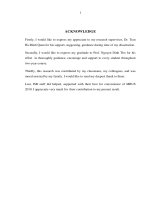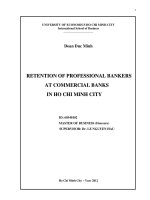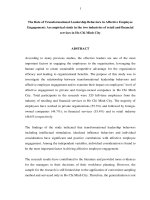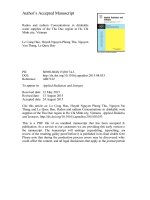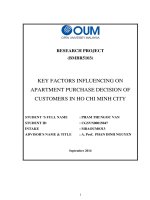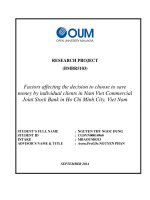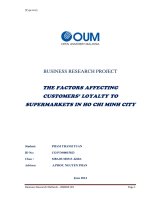Factors affecting job satisfaction of the employees at astrazeneca viet nam in ho chi minh city
Bạn đang xem bản rút gọn của tài liệu. Xem và tải ngay bản đầy đủ của tài liệu tại đây (2.39 MB, 59 trang )
RESEARCH PROJECT
(BMBR5103)
FACTORS AFFECTING JOB SATISFACTION
OF THE EMPLOYEES AT ASTRAZENECA
VIETNAM IN HO CHI MINH CITY
STUDENT’S FULL NAME
STUDENT ID
INTAKE
ADVISOR’S NAME & TITLE
:
:
:
:
HUYNH THI XUAN TRAM
CGS00018491
SEPTEMBER, 2014
A. PROF. NGUYEN PHAN
December – 2015
Advisor’s assessment
.......................................................................................................................................
.......................................................................................................................................
.......................................................................................................................................
.......................................................................................................................................
.......................................................................................................................................
.......................................................................................................................................
.......................................................................................................................................
.......................................................................................................................................
.......................................................................................................................................
.......................................................................................................................................
.......................................................................................................................................
.......................................................................................................................................
.......................................................................................................................................
.......................................................................................................................................
.......................................................................................................................................
.......................................................................................................................................
.......................................................................................................................................
.......................................................................................................................................
.......................................................................................................................................
.......................................................................................................................................
Huynh Thi Xuan Tram |Factors affecting Job Satisfaction of the employees at AstraZeneca VN
2
Table of Contents
ABSTRACT ........................................................................................................ 5
CHAPTER 1: INTRODUCTION ................................................................... 7
1.1 Problem statement: .......................................................................................... 7
1.2 Research Objectives: ........................................................................................ 7
1.3 Research question: ............................................................................................ 7
1.4 Scope and Methodology of Research ................................................................. 8
1.5 Research Structure ........................................................................................... 8
CHAPTER 2: LITERATURE REVIEW ...................................................... 9
2.1 Introduction of AstraZeneca Vietnam ………………………................................ 9
2.2 Notion of job satisfaction ................................................................................ 10
2.3 Theories about job satisfaction ........................................................................ 11
2.3.1 Theory of David Mc. Clelland ......................................................................... 11
2.3.2 Theoretical Framework of David Mc. Clelland ................................................. 11
2.3.3 Hertzberg’s two-factor theory........................................................................... 12
2.3.4 Expectation Theory of Vroom ......................................................................... 13
2.3.5 Maslow’s hierarchy of needs............................................................................. 13
2.3.6 Model of motivation of Porter and Lawler. ....................................................... 14
2.3.7 Model of Job Description Index (JDI) .............................................................. 14
2.4 Studies about the job satisfaction...................................................................... 16
CHAPTER 3: RESEARCH METHODOLOGY ....................................... 17
3.1 Data source:...................................................................................................... 17
3.2 Modeling Specification .................................................................................... 17
3.3 Relation between notions of research and research theory ............................... 19
Huynh Thi Xuan Tram |Factors affecting Job Satisfaction of the employees at AstraZeneca VN
3
3.4 Measurement of observed variables ................................................................ 21
3.5 Design of research ............................................................................................ 22
3.5.1 Design of qualitative research ......................................................................... 23
3.5.2 Design of Scales ............................................................................................ 24
3.5.3 Sample Selection ........................................................................................... 25
3.6 Method of data analysis .................................................................................. 25
3.6.1 Statistics of sample description ....................................................................... 25
3.6.2 Scale assessment ............................................................................................. 25
3.6.3 Explanatory Factor Analysis (EFA) ................................................................. 26
3.6.4 Name and Adjustment of the modeling specification............................................ 27
3.6.5 Construction of regression equation ................................................................. 27
3.7 Evaluation of the fit of the model .................................................................... 27
3.8 Evaluation of research assumptions ................................................................ 28
CHAPTER 4: EMPIRICAL RESULTS AND DISCUSSION ................. 30
4.1 Sample description ......................................................................................... 30
4.2 Scale evaluation .............................................................................................. 31
4.2.1 Evaluation of scale “work itself” ..................................................................... 32
4.2.2 Evaluation of scale “Advancement opportunities” ............................................. 32
4.2.3 Evaluation of Scale “Salary” ........................................................................... 33
4.2.4 Evaluation of Scale “Supervisor support ” ........................................................ 34
4.2.5 Evaluation of Scale “Co-worker relations” ....................................................... 34
4.2.6 Evaluation of Scale “Working conditions” ....................................................... 35
4.2.7 Evaluation of scale of dependent variable “job satisfaction” ............................... 36
4.3 Name and adjustment of the model ................................................................. 37
Huynh Thi Xuan Tram |Factors affecting Job Satisfaction of the employees at AstraZeneca VN
4
4.3.1 Name of the first factor: ................................................................................. 37
4.3.2 Name of the second factor .............................................................................. 38
4.3.3 Name of the third factor ................................................................................. 38
4.4 Adjustment of modeling specification ............................................................... 39
4.5 View the correlation between the notions ........................................................ 40
4.6 Construction of regression equation ................................................................ 41
4.6.1 Construction of regression equation by Enter method ........................................ 41
4.6.2 Examination of the difference between the groups of employees having different age
.............................................................................................................................. 45
4.6.3. Examination of the difference between the groups of employees having different age
.............................................................................................................................. 47
4.7 Discovery of research........................................................................................ 47
CHAPTER 5: CONCLUSION AND PROPOSALS .................................. 49
5.1 Conclusions .................................................................................................... 49
5.2 Some proposals from the research results: ...................................................... 50
5.3 Contributions and meanings of the research .................................................... 52
5.3.1 Contributions ................................................................................................ 53
5.3.2. Meanings of the research................................................................................. 53
5.3.3 Limitation of the research: ............................................................................... 53
REFERENCES ................................................................................................ 55
APPENDIX ....................................................................................................... 57
Huynh Thi Xuan Tram |Factors affecting Job Satisfaction of the employees at AstraZeneca VN
5
ABSTRACT
The Pharmaceutical industries in Viet Nam are facing the critical challenges of recruiting
and retaining the best talents. In this era of globalization employees are blessed with good
opportunities. There are many factors which influence retention and it is required to
understand employee expectation. When highly desirable employees decide to leave, it can
have a significant negative impact on the organization. Recruitment costs, training costs,
low productivity, loss of critical knowledge and operational disruptions can decrease
organizational effectiveness.
According to the literature, when employees are satisfied, they intend to stay in the
organization and when they are dissatisfied, they think about quitting. Furthermore, if the
employee perceives employment opportunities in the labor market, the intention to quit or
stay is affected. To support business optimally, need is to retain existing talented
employees who have the essential knowledge, expertise and competencies to do the work.
The Research project was designed to find out the factors which influence Job Satisfaction
of employee working at AstraZeneca Viet Nam from that increases intention to stay and
work performance for employees
Data were collected from 200 Medical Representatives of AstraZeneca from Sixty - four
Provinces and cities in Vietnam. Using software SPSS version 22 (copyright of IBM).
Hypotheses used this research includes five constructs: one dependent construct (Job
Satisfaction) and four independent constructs (Staff Relations, Supervisor, pay and
opportunity to develop) that important factors are key indicators for employee retention,
satisfaction, and productivity.
Huynh Thi Xuan Tram |Factors affecting Job Satisfaction of the employees at AstraZeneca VN
6
CHAPTER 1: INTRODUCTION
1.1 Problem statement:
Nowadays, keeping good staffs staying with the company becomes more important. The
stability of human resource assists the firm economizes fees (training, recruitment) and
also reduces potential professional mistakes, creating belief and forming the culture of the
company. Thus, employees will consider the company as the perfect location to fulfill all
their capabilities as well as stay with the firm in the long term. Last but not least, this
stability assists the enterprise do effectively their business, creating the confidentiality of
customers to the quality of goods and service of the company. Investigations show that the
satisfaction of the employees has positive effect on working results (Sari & Judge, 2004) or
the loyalty for the organization (Luddy, 2005).
Great employees are the lifeblood of any business. However, as the job market accelerates,
even happy workers may be tempted to explore whether the grass is greener at another
company. Within 2 years (2014-2015), more than 160 Medical Representative in Vietnam
has resigned, And Losing employees is a concern for AstraZeneca. Every Year, The
Company are losing 20 percent of the employee’s annual salary for replacing an employee
to cover the lost productivity costs and then recruit and train someone new. With the
shortage of human capital as today, retention good people are becoming big issue of
AstraZeneca Viet Nam. And Job Satisfaction of employees is important factor for
AstraZeneca to keep employee retention, Even though there are numerous studies related
to job satisfaction but there is limited research done in different country contexts
Therefore, this study will mainly look into the four factors: Staff Relations, Supervisor,
pay and opportunity to develop that influence on job satisfaction of AstraZeneca Staff.
Hence, the evaluation of the factors affecting the job satisfaction of the employees is very
essential in order that the enterprises can adjust human resource policies suitably.
Huynh Thi Xuan Tram |Factors affecting Job Satisfaction of the employees at AstraZeneca VN
7
1.2 Research Objectives:
This goal of this research is way to find the factors influence to the Job Satisfaction of
employees working at AstraZeneca Viet Nam. The primary objectives of this study will
focus on:
(1) To determine the factors influencing the satisfaction of the employees in the company
(2) To propose the solutions to improve the satisfaction of the employees in order to keep
competent staffs and impulse the labor productivity.
1.3 Research question:
Specifically, the research aims to address the following questions:
(1) Which factors influence the satisfaction of the employees?
(2) What are the solutions to enhance employee’s job satisfaction?
1.4 Scope and Methodology of Research
The research focuses on investigating the job satisfaction of employees in AstraZeneca
Vietnam in Ho Chi Minh City. The subjects are staffs working actually in the company;
the sample size of the research is 200 people collected, surveyed in the number of different
departments in the company. In order to clarify the contents above, serving for the target of
the research, the dissertation use specific research methods as:
- Preliminary study is implemented through qualitative research, through the technique of
consulting the opinions of specialists and experienced professors in this field, at the same
time observing on the working location, discussing with the superiors and colleagues.
- Official study is used by quantitative research through the survey of 200 staffs in the
company. Collect and process the data with the software SPSS. Conduct the survey for the
study in the end of 2015 at AstraZeneca Vietnam.
1.5 Research Structure
The research is organized in five chapters, including this introduction.
Huynh Thi Xuan Tram |Factors affecting Job Satisfaction of the employees at AstraZeneca VN
8
Chapter 2: Reviews theories the general theory related to the research including the general
information of AstraZeneca Vietnam, the notions in the research model, the research
models and some recent studies of similar topic.
Chapter 3: Describes data collection and methodology in which the model for estimation
and method of estimation are outlined.
Chapter 4: Presents the results from analyzing data and discussion.
Chapter 5: Briefly draws the conclusion, recommendations and limitations of the research.
Huynh Thi Xuan Tram |Factors affecting Job Satisfaction of the employees at AstraZeneca VN
9
CHAPTER 2: LITERATURE REVIEW
This chapter will present the general theory related to the topic of the research including
the general information of AstraZeneca Vietnam, the notions in the research model, the
research models and some recent studies of similar topic.
2.1 Introduction of AstraZeneca Vietnam
AstraZeneca plc is a British-Swedish multinational pharmaceutical and biologics
company. We are the world's seventh-largest pharmaceutical company. Our primary focus
is the discovery, development and commercialization of prescription medicines for six
important areas of healthcare: Cardiovascular, Gastrointestinal, Infection, Neuroscience,
Oncology and Respiratory & Inflammation.
The organizational hierarchy of the company includes Board of directors, Chief Executive
Officer, Deputy Chief Executive Officers, Executive Director, Deputy Director,
departments: Financial and Accounting Department, Human Resource and Administration
Department, Engineering Department (operation, reparation, maintenance, customer care),
Sales Department, Project Department (5 construction team) and Warehouse, with the
workforce is 303 people.
We operate in over 100 countries and our innovative medicines are used by millions of
patients worldwide. We are one of only a handful of companies to span the entire lifecycle of a medicine from discovery, early and late-stage development, to the global
commercialization of primary care, specialty care-led and specialty care medicines. Using
these skills and capabilities we can make a real difference to the health of a broad range
of patients by delivering great medicines in disease areas where there is unmet medical
need.
We want AstraZeneca to be valued as a source of great medicines and trusted as a
company that delivers business success responsibly. Our Responsible Business Plan
provides the framework for ensuring that we operate with integrity and high ethical
standards across all our activities.
In Viet Nam, we are currently one of the top pharmaceutical companies and we are
committed to continued innovation, close customer relationships, people development
Huynh Thi Xuan Tram |Factors affecting Job Satisfaction of the employees at AstraZeneca VN
10
and an ethical responsible approach to business, with an aim to make a difference to the
lives of patients and the healthcare professionals.
2.2 Notion of job satisfaction
Job satisfaction is a complex phenomenon that has been studied quite extensively. Various
literature sources indicate that there is an association between job satisfaction and
motivation, motivation is hard to define, but there is a positive correlation between job
satisfaction, performance and motivation, whereby motivation encourages an employee,
depending on their level of job satisfaction, to act in a certain manner (Hollyforde, 2002).
In the earlier studies job satisfaction is described as a combination of psychological,
physiological and environmental factors that cause a person to feel satisfied with his or her
job. This description implies that internal and external factors affect feelings of employees.
Locke (1976) who described job satisfaction as "a pleasurable or positive emotional state
resulting from the appraisa1 of one's job or job experiences" has been cited very often in
job satisfaction research (as cited by Parvin, 2011). His definition indicates that job
satisfaction is an emotional state and a result of an appraisal or evaluation of one’s job.
Simply said job satisfaction was described as the positive and negative feelings and
attitudes people have regarding their job. This implies that the evaluation of one’s job,
results in negative or positive feelings (Khalifa, 2010). According to Kreitner et al (2002)
job satisfaction is an affective and emotional response to various facets of one’s job. The
complexity of job satisfaction becomes apparent when one realizes that a variety of aspects
regarding the job can result in negative or positive feelings. Also Falkenburg and Schyns
(2007) argue that job satisfaction consists of satisfaction with different aspects of the job
and work situation. Thus, job satisfaction has often been seen as a multi-faceted concept,
which affects satisfaction with one’s job. Job satisfaction facets, which have been
identified in research, are numerous but mostly regard internal and external factors related
to the job.
2.3 Theories about job satisfaction
2.3.1 Theory of David Mc. Clelland
David Mc. Clelland (quoted as Robbins, 2002) stated that people have 3 elementary needs:
performance need, union need and power need. (1) Performance need. People who have
Huynh Thi Xuan Tram |Factors affecting Job Satisfaction of the employees at AstraZeneca VN
11
high performance need are who always desire to perform their job better. They want to
pass all the difficulties and obstacles. They want to feel that all the success or failure is the
results from their actions. It means that they love challenged jobs. People having high
performance needs are encouraged to work better. The characteristics of persons having
high performance are: the desire to realize individual responsibilities, the tendency to put
high targets for themselves, the high need of concrete and immediate response, and quick
control of their job. (2) Union need. People, like in the social need of A. Maslow, are who
want to accept love and friendship. The employees have this need perform strongly and
well the jobs creating the friendliness and social relationship. (3) Power need: Is the need
to control and influence on the others and their working environment. Researchers reveal
that people who have strong power and performance needs have tendency to become
managers. Some people state that a succeed manger is who have the strongest power need,
then performance need and lastly union need.
2.3.2. Theoretical Framework:
Hagedorn‟s (2000) Conceptual Framework of Faculty Job Satisfaction will serve as the
basis for this study. Hagedorn‟s used National Survey of Post-Secondary Faculty:93
(NSOPF) data to create this framework, which was adapted from Herzberg‟s MotivationHygiene Theory to specifically study university faculty. Hagedorn‟s framework includes
two types of concepts that work together to affect job satisfaction: triggers and mediators.
Hagedorn (2000) defines a trigger as “A significant life event that may be either related or
unrelated to the job” (p. 6).
Hagedorn defines a mediator as “A variable or situations that influence the relationships
between other variables or situations producing an interaction effect” (p. 6). The
framework contains six triggers: (1) change in life state; (2) change in family-related or
personal circumstances (e.g. birth, death, divorce, illness of self or significant other); (3)
change in rank or tenure; (4) transfer to a new institution; (5) change in perceived justice;
and (6) change in mood or emotional state (Hagedorn, 2000, p. 7). There are three types of
mediators: (1) motivators and hygienes such as salary or work itself; (2) demographics
such as gender or academic discipline; and (3) environmental conditions such as
institutional climate/culture and collegial relationships. The mediators of salary and
demographics such as gender, family status, whether or not there are children living in the
Huynh Thi Xuan Tram |Factors affecting Job Satisfaction of the employees at AstraZeneca VN
12
home, and number of children living in the home will be examined in this study, in
addition to the variables of rank and tenure status.
Hagedorn‟s Conceptual Framework of Faculty Job Satisfaction is based on Herzberg‟s
(1959) Motivation-Hygiene Theory, which divided the work into two factors: motivators
and hygienes. Motivators are issues that increase satisfaction and hygienes as issues that
decrease dissatisfaction or result in de-motivation. Herzberg, Maunser, and Snyderman
(1959) found that intrinsic factors, such as achievement, recognition, work itself,
responsibility, advancement, and salary, lead to satisfaction; hence, these factors are named
motivators and labeled as job satisfiers. Herzberg et al. also found that extrinsic factors,
such as company policy, supervision, relationship with boss, work conditions, salary, and
relationships with peers, lead to dissatisfaction; hence, these factors are named hygienes
and labeled as job dissatisfiers. Herzberg et al.‟s research has been verified through
numerous studies and has served as the basis for many job satisfaction assessments.
Hagedorn‟s (2000) adaptation of Herzberg‟s Motivation-Hygiene Theory has been used in
many studies over the last 10 years (August & Waltman, 2004; Grunwald & Peterson,
2003; Corley & Sabharwal, 2007; Castillo & Cano, 2004). This framework has also been
used in numerous dissertations. The main purpose of this study is to add to the literature
regarding job satisfaction among Medical Representative at AstraZeneca Vietnam. As
such, Hagedorn‟s research is a useful tool to frame this study.
2.3.3 Hertzberg’s two-factor theory:
In the late 1950s Frederick Herzberg developed a theory that there are two dimensions to
job satisfaction, “motivation” and “hygiene”. The work characteristics associated with
dissatisfaction (hygiene factors) vary from those pertaining to satisfaction (motivators) in
that motivators lead to satisfaction, although their absence may not lead to dissatisfaction.
The motivators include achievement, recognition and intrinsic interest in the work itself.
The continuing relevance of Herzberg is that there must be some direct link between
performance and reward, whether extrinsic as in recognition or intrinsic as in naturally
enjoyable work, to motivate employees to perform and improve their job satisfaction. The
current study will be based upon this theory.
2.3.4 Expectancy theory:
Huynh Thi Xuan Tram |Factors affecting Job Satisfaction of the employees at AstraZeneca VN
13
This theory was developed by Vroom(1964) who asserts that job satisfaction is based on
people’s beliefs about the probability that their effort will lead to performance
(expectancy) multiplied by the probability that performance leads to rewards
(instrumentality) and the value of perceived rewards (valence).This theory is based on the
belief that the amount of effort exerted on a job depends on the expected return and may
result in increased pleasure or decreased displeasure, and that people may perform their job
and be satisfied if they believe that their efforts will be rewarded. The fundamental
principle of expectancy theory is the understanding of individuals’ goals and the linkages
between effort and performance, performance and rewards, and rewards and individual
goal satisfaction. This theory recognizes that there is no universal principle that explains
people’s motivation and is regarded as a contingency model. Understanding what needs a
person seeks to satisfy does not ensure that the individual perceives high performance as
necessarily leading to the satisfaction of these needs. The theory of Vroom can be
interpreted by the formula:
The motivation = Degree of desire x Degree of expectation
When one person is indifferent to reaching the goals, the degree of desire seems to be zero,
and the latter will be negative if people refuse to attain this goal. Similarly, one person can
have no motivation to reach the target if the expectation is zero or negative.
2.3.5 Maslow’s hierarchy of needs:
According to Maslow’s theory (1970), people’s needs range from a basic to a high level.
These needs are present within every human being in a hierarchy, namely physiological,
safety and security, social, status and self-actualization needs. Failure to satisfy one need
may have an impact on the next level of need. Low order needs takes priority before the
higher order needs are activated, so that needs are satisfied in sequence. According to this
theory, people who are struggling to survive are less concerned about needs on the higher
levels than people who have time and energy to be aware of higher level needs
2.3.6 Model of motivation of Porter and Lawler.
L.W. Porter and E.F. Lawler (1974) went to a model of motivation more perfect, in which
the majority is built on the theory of expectation. As the model show, the entire of the
effort or the power of motivation depends on the values of awards and the probability or
Huynh Thi Xuan Tram |Factors affecting Job Satisfaction of the employees at AstraZeneca VN
14
the possibility to receive the awards. Then, the results of achieving the mission is
determined by the motivation, working capability of human (knowledge and competence)
and the perception of essential missions. A good execution of duties inevitably leads to
inherent awards (money, items) and outside awards (working conditions, positions). These
awards along with the awards suited to the perception (it means that each individual
perceive the suitability and the equality for the awards) produce the satisfaction. Hence, the
satisfaction is the outcome combined of different awards.
2.3.7 Model of Job Description Index (JDI)
Model of Job Description Index have been presented by Smith et al since 1969. Model of
Job Description Index is highly appreciated through various researches; according to the
statistics of Worrel (2004) the implications of JDI in the measurement of job satisfaction of
the employees have had 12,000 studies about JDI (Worrel, 2004). Basically, the model of
Smith has 5 factors as follows:
The nature of suitable job: Is understood that one job will bring the general satisfaction to
the employees and create good results if it meets these characteristics: Using different
skills, staffs master working process and the job plays an important role given to the
commercial activities of the company. Besides, the job is well-suited to the competence
given of the employees.
Training and promoting opportunities: Training is the process of inquiring essential skills
to handle one concrete task. Promotion is the movement to the higher position in the
working system of the employees. In this topic, training and promotion are grouped in the
same factor because of their regular relation cause – result. The objective of training
employees, apart from improving the competences, is also to promote in the working
system, they have closed relation.
Income factor: Is the compensation that the employees receive from their job in the
company. In this research, the income is the one that the employees receive from their job
in the company, not including the other revenue aside from their principal job in the
company. Income factor is a principal factor influencing job satisfaction of the employees,
staffs have comparison of income with other enterprises, and the revenue is distributed
equally to member.
Huynh Thi Xuan Tram |Factors affecting Job Satisfaction of the employees at AstraZeneca VN
15
Leader factor: Leader is understood as the direct superior of employees. Leaders bring
satisfaction to the employees through communication, interest, attention to their
employees, protect their staffs if necessary, and express their leading competences and
profession to their inferiors. Besides, the satisfaction of leaders of employees is
represented through equal treatment, sincere certificate of distribution of employees.
Lastly, colleagues: Colleagues means people working together at the same position,
having the similar working missions or relating in the professional chain in an
organization. In this content of research, colleagues are understood as people working in
the same direct unit, in the same company, having mutual working relationship,
exchanging about the job. In the majority of working time, employees have mutual contact;
thus, the relation between colleagues influences the job satisfaction. The principal factors
affecting job satisfaction are the confidentiality, the devotion to the job, the help, the
friendliness, etc….
2.4 Studies about the job satisfaction
Investigations of job satisfaction of the employees are conducted early on (study of
Hoppock, 1935) and are carried out by different researchers. In this research, the author
presents only some typical studies in the world and in Viet Nam about the same field.
The first one is the study of Smith, Kendall and Hulin (1969) of Cornell University. Study
built Job Description Index (JDI) to evaluate the job satisfaction of one person through
factors including (1) job nature, (2) income, (3) promotion, (4) colleagues and (5)
supervision of the superior. The study of Spector (1985) in the field of services, the
evaluation of the degree of satisfaction has 9 factors: (1) salary, (2) opportunities of
promotion, (3) working conditions, (4) supervision, (5) colleagues, (6) love of job, (7)
information communication, (8) unexpected awards, (9) benefits. The research of Luddy
(2005) in the field of medical services in South Africa show that the job satisfaction of
employees are affected by all 5 factors in the model JDI, in which, 3 factors “colleagues”,
“leadership” and “ job nature” are highly appreciated by the workers, 2 factors “training
and promotion” and “income” are negatively rated (dissatisfaction). In Vietnam, the
research of Tran Kim Dung (2005) conducted in Ho Chi Minh City reveals that there are 7
factors affecting job satisfaction of employees including (1) job nature, (2) training and
Huynh Thi Xuan Tram |Factors affecting Job Satisfaction of the employees at AstraZeneca VN
16
promotion, (3) salary, (4) leadership, (5) colleagues, (6) welfare of the company, and (7)
working conditions. The study of Nguyen Lien Son (2008) in Long An state that there are
6 factors affecting job satisfaction of employees including (1) job nature, (2) salary, (3)
colleagues, (4) leadership, (5) training and promotion opportunities and (6) working
conditions. Research of Nguyen Thi Thu Thuy (2011) examining the satisfaction of
professors in the universities in Ho Chi Minh City says that 4 factors influencing the
satisfaction of professors of the universities are (1) colleagues, (2) income, (3) job
characteristics and (4) leadership. Study of Pham Van Manh (2012) reckons that in the
telecom field, 4 factors having impact on satisfaction of employees are (1) colleagues and
welfare, (2) training and promotion, (3) autonomy, and (4) working conditions, in which,
working conditions are negatively evaluated.
Huynh Thi Xuan Tram |Factors affecting Job Satisfaction of the employees at AstraZeneca VN
17
CHAPTER 3: RESEARCH METHODOLOGY
3.1 Data source:
Data from the research are collected through the establishment of survey of questionnaire,
in which the questions are mainly oriented to the factors affecting the satisfaction of
employees, and then distribute the survey paper collecting directly the opinions of
employees in AstraZeneca Vietnam, certain survey questions are sent by mail. Data
collected will be processed, removing invalid papers, then using the software SPSS to test
the hypothesis.
3.2 Modeling Specification
Modeling specification is built on the basis of the model of Job Description Index
developed by Smith et al (1969), combined with the reference of the studies in Vietnam.
Through the conduction of qualitative research, the factor of “working conditions” is the
one that the employees consider significance. Therefore, in this research, the author
supplements the factor “working conditions” in the modeling specification. Thus, the
modeling specification has 6 factors as follows (see the figure 3.1.1).
(1) Work itself
(2) Advancement opportunities
(3) Salary
(4) Supervisor support
(5) Co-worker relations
(6) Working conditions
Huynh Thi Xuan Tram |Factors affecting Job Satisfaction of the employees at AstraZeneca VN
18
The Figure 3.1.1 Modeling specification
Work itseft
H1
Advancement
opportunity
H2
H3
Salary
Job satisfaction
H4
Supervisor
support
H5
H6
Co-worker
relations
Working
Conditions
3.3 Relation between notions of research and research theory
Work (job nature) is the content of tasks suited to the capabilities of the employees,
creating the inspiration to the workers in order to perform their competences. Arranging
the missions suitably can exploit the potentiality of the employees, increasing the
productivity and making the workers comfortable when working. In the other words, the
employees will be satisfied with the tasks assigned if the job is suited to their capabilities.
This is proven by research of John. D Pettit et al (1997), study of T. Ramayah et al (2001)
Huynh Thi Xuan Tram |Factors affecting Job Satisfaction of the employees at AstraZeneca VN
19
in Malaysia, research of Kenichi et al (2002), research of Luddy (2005), study of Tran Kim
Dung (2005), Nguyen Lien Son (2008), Nguyen Thi Thu Thuy (2011)… All show that the
employees are satisfied with the job nature assigned, influencing the job satisfaction.
Hence, this research gives research hypothesis:
H1: Working factor has positive impact on the general job satisfaction of employees.
Training and promoting opportunities reveal that the workers are given the opportunities to
be trained to enhance skills serving for the job and the ability to be promoted to higher
position. The employees will be satisfied with the job offering training opportunities and
helping to be promoted in their careers. Therefore, creating training opportunities and
promotion makes the employees satisfied with the job. This has been proven by research
Spector (1985), JH Ironson et al (1989), Jonh. D Pettit et al (1997), T. Ramayah et al
(2001) and Stanton (2001), Kinicki et al (2002), Luddy (2005), Tran Kim Dung (2005),
Nguyen Lien (2008), Pham Van Manh (2012), etc. Then, this research put the hypothesis:
H2: The factor of training and promoting opportunities has positive impact on the general
job satisfaction of employees. Career development determines the nature and quality of
individuals’ lives, and the social and economic contribution they make. Career
development is crucial for an effective labour market. When individuals find a career path
that utilizes their full potential, they are likely to be motivated and productive thus
increasing job satisfaction. Opportunities to develop afford individuals the prospect of
further enhancing themselves and growing within the ranks of their career.
The availability of career development opportunities illustrates the willingness and effort
of the organization to cherish employees. Huselid (1995) suggested that progressive HR
practices that embrace career-related practices could improve knowledge, skills and the
abilities of an organization’s current and potential employees, and enhance the retention of
quality employees. .Career development is about the development of employees that is
beneficial for both the individual and the organization. Effective career development
programs enhance individual work performance by continuously learning and adapting,
while the organization offers favorable developmental relationships with their employees.
Rhoades and Eisenberger (2002) suggested training and exposure may imply a high level
of concern for organizations to extend employees’ potential in the organization. Employees
Huynh Thi Xuan Tram |Factors affecting Job Satisfaction of the employees at AstraZeneca VN
20
who receive such developmental opportunities would boost their motivation and
confidence in their work. Subsequently, employees who receive such opportunities might
repay their organization with the likeness of extending their self-fulfillment, leading to
reduced turnover intention. Thus, this study poses research hypothesis:
H3: The factor of income has positive impact on the general job satisfaction of employees.
Leaders are the superiors, the managers of the employees; leaders bring to the employees
the satisfaction through communication, fair treatment and recognition of the contributions
of the employees. In the other words, the leadership factor influences positively on the job
satisfaction of workers. This has been proven through research of Spector (1985), Jonh.D
Pettit et al (1997), Lilia Cortina and Vicki J. Magley M (2011), T. Ramayah et al (2001),
Luddy (2005), Tran Kim Dung (2005), Nguyen Lien (2008), Nguyen Thi Thu Thuy
(2011), etc. Thus, this study poses research hypothesis:
H4: The factor of leadership has positive impact on the general job satisfaction of
employees. Colleagues are who work at the same position, perform the similar working
content. The relationship between colleagues is competitive and supportive relations. The
employees will be satisfied with the job if their jobs are well supported from the
colleagues, friendly colleagues help mutually when working as well as there are fair
competition of awards and promotion in the organization. In the other words, the
employers will be more satisfied with the job when having good relationship with
colleagues. This has been proven through research Ramayah T. et al (2001), Luddy (2005),
Tran Kim Dung (2005), Nguyen Lien (2008), Nguyen Thi Thu Thuy (2011), Pham Van
strong (2012), etc. Thus, this study poses research hypothesis:
H5: The factor of colleagues has positive impact on the general job satisfaction of
employees. Working conditions are working situation of the workers including the
following factors: the safety of workplace, the equipment serving for the job of the
employees… The workers provided good working conditions will highly appreciate their
jobs; otherwise they will be dissatisfied with the working conditions they have to accept.
This has been proven in studies of Spector (1985), Tran Kim Dung (2005), Nguyen Lien
(2008), Pham Van Manh (2012), etc. Thus, this study poses research hypothesis:
Huynh Thi Xuan Tram |Factors affecting Job Satisfaction of the employees at AstraZeneca VN
21
H6: The factor of working conditions has positive impact on the general job satisfaction of
employees.
3.4 Measurement of observed variables
Table 1: Table of recording variables
STT
Code
I
Work itself
1
CV1
Content of questions
References
The job is accorded to professional
Tran Kim Dung
qualifications, suited to training skills
(2005)
Nguyen Lien Son
2
CV2
Understand well the job
(2008)
3
CV3
Permit to use well individual competences
4
CV4
Be stimulated to imagine when working
5
CV5
The job has many challenges, interests;
6
CV6
The mass of tasks is suitable
7
CV7
Working time is suitable
II
Advancement opportunities
8
DT1
Be trained completely professional skills
Tran Kim Dung
(2005)
9
10
DT2
DT3
Offer occasion to educate to improve
Nguyen Lien Son
Qualifications
(2008)
Opportunities to promote for competent
Huynh Thi Xuan Tram |Factors affecting Job Satisfaction of the employees at AstraZeneca VN
22
11
DT4
Occasion to develop himself
12
DT5
Fair policy of training and promotion
III
Salary
13
TN1
Salary is suited to competence and
14
TN2
Fair awards for the working efficiency
Tran Kim Dung
(2005),
Nguyen Lien Son
15
TN3
Reasonable allowance
16
TN4
Salary, awards and allowance are distributed
(2008)
Fairly
17
TN5
Possibility to live based on the income
18
TN6
Income is equal to other companies
IV
Supervisor support
19
LD1
Leaders are interested in subordinates
20
LD2
Workers receive the assistance of leaders
Tran Kim Dung
(2005),
Nguyen Lien Son
when working
(2008)
21
LD3
Leaders treat fairly
22
LD4
Leaders have competences, visions and
ability of good management
V
Co-worker relations
23
DN1
Colleagues are willing to help each other
Tran Kim Dung
(2005),
24
DN2
Colleagues coordinate well when working
Huynh Thi Xuan Tram |Factors affecting Job Satisfaction of the employees at AstraZeneca VN
23
25
DN3
Colleagues are friendly
26
DN4
Colleagues are confident
VI
Working conditions
27
MT1
Working environment are clean and hygienic
28
MT2
Employees do not worry about losing the job
Nguyen Lien Son
(2008)
Tran Kim Dung
(2005),
Nguyen Lien Son
29
MT3
Employees work in safe conditions
30
MT4
Employees work in an environment fully
(2008)
equipped to support the job
31
MT5
Working depression is not too high.
VII
Job satisfaction
32
TM1
Job permits you to utilize well your
Tran Kim Dung
individual competences
(2005),
33
TM2
Job is interesting
34
TM3
Job have several challenges
Nguyen Lien Son
(2008)
3.5 Design of research
3.5.1 Design of qualitative research
Method of qualitative research is used in the period of research discovery: research
secondary documents and discuss with some employees to discover, adjust, supplement
observed variables, and construct preliminary scales about the satisfaction of employees in
the company. This method is implemented during interviewing, exchanging directly with
some staffs working in the company. There are various opinions but basically, these ideas
approve with the content in the model of Job Description Index. Besides, these employees
Huynh Thi Xuan Tram |Factors affecting Job Satisfaction of the employees at AstraZeneca VN
24
state that working conditions is one of the issues making them dissatisfied. They say that
working conditions is also an important factor to evaluate the job satisfaction of
employees. Many participants say a lot about their actual job, especially the staffs having
big ambition to promote. They want to have specific responsibilities, concrete in the
position that they are assigned, at the same time, they desire to contribute their voice in the
decision of their leaders. Through this qualitative analysis, the author supplements one
factor “working conditions” in the modeling specification. At the same time, he will
conduct the adjustment of the questionnaire survey expected to give factors in the model
JDI accorded semantically.
3.5.2 Design of Scales
The construction of scales in the research is an essential mission of all studies; the
selection of suitable scales will assist researchers ease to analyze the research and discover
the issues studied. In this research, the author use 5-point Likert Scale. In principle, more
the scale is detailed, more it is accurate, but the 5-point Likert Scale is suited to this
research, the accuracy is nearly equal to the 7-point Likert Scale because in the feature of
distinction of semantic level of agreement in Vietnamese language, there is no difference
between 5-point Likert Scale and 7-point Likert Scale. Dummy variables are built by
nominal scales and ordinal scales. Concretely as follows:
Huynh Thi Xuan Tram |Factors affecting Job Satisfaction of the employees at AstraZeneca VN
25

